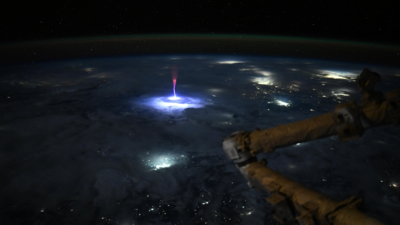Astronaut Captures Elusive Red Sprite from Space, Aiding Atmospheric Research
While orbiting above North America, NASA astronaut Nichole Ayers photographed a rare atmospheric phenomenon: glowing red lights shimmering in Earth’s upper atmosphere. This event, known as a Transient Luminous Event (TLE), or more commonly a "sprite," manifested as a fleeting burst of red light above thunderstorms spanning Mexico and the United States.

Image: A red sprite, a Transient Luminous Event, captured by astronaut Nichole Ayers from the International Space Station.
Sprites are brief flashes of red light that occur high above powerful thunderstorms. These massive bursts of electrical energy can reach up to 100 kilometers above Earth’s surface. They are composed of “cold plasma,” resembling the glow inside a fluorescent light tube more than typical lightning.
Due to their altitude and short duration, sprites are rarely visible from the ground. This makes Ayers’ space-based capture particularly significant for scientific study.
Ayers shared the image on X, stating, “Just. Wow. As we went over Mexico and the U.S. this morning, I caught this sprite.” She further explained that "Sprites are TLEs or Transient Luminous Events, that happen above the clouds and are triggered by intense electrical activity in the thunderstorms below.”
Sprites have intrigued scientists and pilots for decades. These short-lived, jellyfish-shaped flashes ascend into the atmosphere and disappear within milliseconds. For almost a century, pilots reported sightings, but many scientists dismissed these reports as myths or optical illusions. This changed in 1989 when the first clear image of a sprite was accidentally recorded.
NASA explains that sprites occur when strong lightning discharges interact with Earth’s ionosphere. The reddish glow is produced as the discharge travels upward and collides with nitrogen molecules. Sprites are classified within a broader category of upper-atmosphere phenomena that includes blue jets and red elves.
The captured image sparked amazement and curiosity online. One user commented, “Sprite.... one of the rarest of rare celestial phenomenon.” Another user inquired about the duration and altitude of the sprite, highlighting the vastness of what remains unknown about these events. “How long do the sprites last? Is this a still shot taken from a video? What altitude did this one reach? The more we find out, it becomes obvious we know far less than we thought.”
Newer articles
Older articles
 Daren Sammy Fined, Handed Demerit Point for Umpire Criticism After Test Match Comments
Daren Sammy Fined, Handed Demerit Point for Umpire Criticism After Test Match Comments
 Gavaskar Calls for Yadav's Inclusion, Questions Middle Order After India's Test Defeat
Gavaskar Calls for Yadav's Inclusion, Questions Middle Order After India's Test Defeat
 Decoding Your Health: Spotting 5 Prediabetes Warning Signs Before a Blood Test
Decoding Your Health: Spotting 5 Prediabetes Warning Signs Before a Blood Test
 Facial Icing: Benefits, Risks, and Safe Application of This Viral Beauty Trend
Facial Icing: Benefits, Risks, and Safe Application of This Viral Beauty Trend
 Headline:
Early Warning Signs: 5 Heart Attack Symptoms to Watch Out For Weeks in Advance
Headline:
Early Warning Signs: 5 Heart Attack Symptoms to Watch Out For Weeks in Advance
 X Corp. Cracks Down: Half a Million Indian Accounts Suspended for Policy Breaches
X Corp. Cracks Down: Half a Million Indian Accounts Suspended for Policy Breaches
 MI New York's Tajinder Dhillon Shines: From IPL Benchwarmer to MLC Star
MI New York's Tajinder Dhillon Shines: From IPL Benchwarmer to MLC Star
 Mastering JPG to PDF Conversion: A Graphic Designer's Guide to Quality and Efficiency
Mastering JPG to PDF Conversion: A Graphic Designer's Guide to Quality and Efficiency
 Chess Sensation Praggnanandhaa Joins Magnus Carlsen's Team Liquid for Esports World Cup
Chess Sensation Praggnanandhaa Joins Magnus Carlsen's Team Liquid for Esports World Cup
 Akmal Blasts PCB's Interim Coach Choice: Ex-Cricketer Questions Logic Behind Mahmood Appointment
Akmal Blasts PCB's Interim Coach Choice: Ex-Cricketer Questions Logic Behind Mahmood Appointment